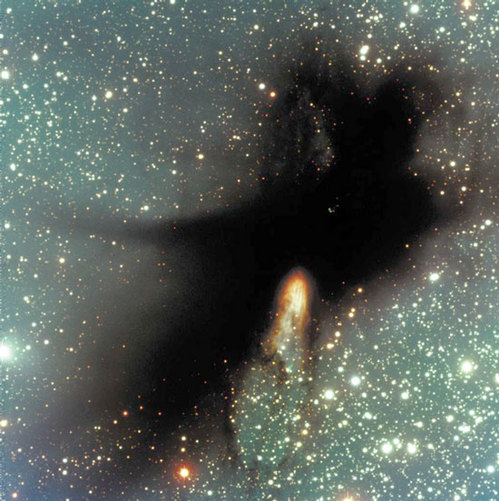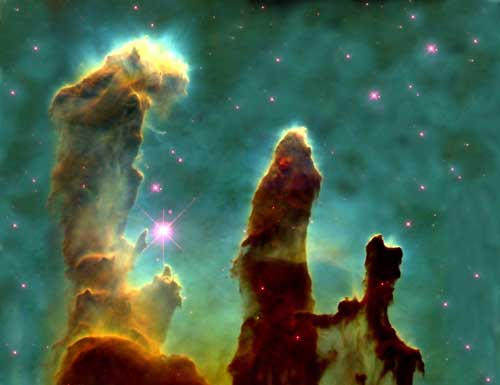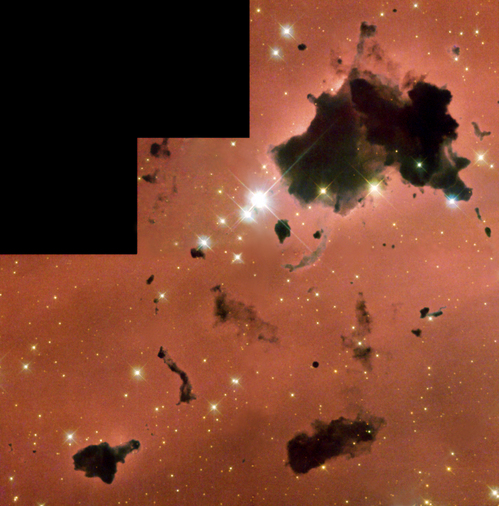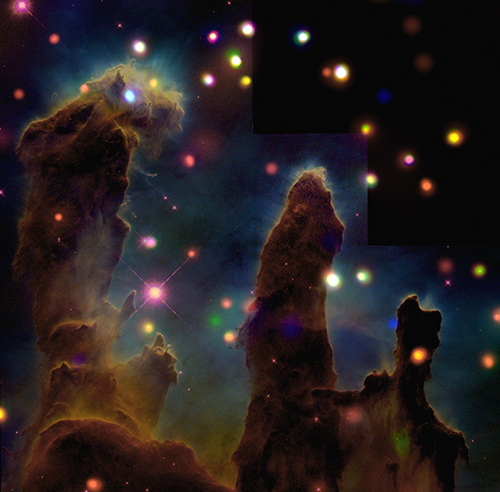Better to light a candle than to curse the darkness. -Chinese Proverb
Every once in a while, we'll look out into the sky with a telescope, and see some spectacular glowing gas.

These nebulae typically come about from dead or dying stars, and are some of the most spectacular sight in the sky for astronomers, from amateur to professional.
But in the 1940s, an astronomer named Bart Bok observed these little dark "defects" in a few of these nebulae. It looked like something dark was simply sucking in all of the light around it, and refused to let any out.

In fact, looking even with modern technology (like the Hubble space telescope), we can see that a few of these regions are loaded with these weird globs of darkness.
(FYI, those black squares at the upper left tell you that this was taken with Hubble's old camera, WFPC2.)
These are named Bok globules after their discoverer, but for a long time, we didn't really know what they were. Of course, they must be gas and dust that blocks the light, but what was going on inside of them?
In 1947, Bok and Edith Reilly wrote what they hypothesized was going on in these globules.

Similar to an insect's cocoon, they said, "these probably represent the evolutionary stage just preceding the formation of a star." Only, for over 40 years, there was no way to look for them.
It was only in 1990, seven years after Bok's death, that they were able to confirm that, indeed, there are stars being born in these collapsing regions! Why did it take so long? Because we needed to look in infrared light to find the signatures of star birth, since visible light is unable to make it through these dark globules.
And today? Let's take a look at the famous "pillars of creation" in the Eagle Nebula.

These are clearly collapsing regions of gas and dust, but are there stars forming there? Again, visible light is no help. But if we look to our X-ray telescope, Chandra, what do we find?
Amazing! Sometimes, we get it right on our first guess, even if it isn't confirmed until beyond our lifetimes. It's one of the best feelings a scientist can get, is to be on the cutting edge and make an educated guess, and turn out to be right!
So I'm curious now: of all the educated guesses scientists are making, what do you think are the ones likely to turn out to be right?






Comments
Oooo.. wow - I'm very excited for the comments in response to your question. I immediately scrolled down to read.
I'm hoping for human teleportation devices to really hit mainstream society in the next 50-100 years. It might warp the crap out of space/time and create spontaneous gravity pools - but only if we do it wrong. Get on it, nerds!
Posted by: L. Jerome | March 6, 2010 12:48 AM
As far as hunches go, I'd say:
Kepler will discover a large number of planets and moons in the Goldilocks zone.
The LHC will not discover the Higgs Boson.
*shrug*
Posted by: toad | March 6, 2010 1:34 AM
It can be a little disappointing not being able to confirm your ideas. Large projects have some similarities; some people work so hard to get funding for an instrument they have in mind and they're gone before it is finished and launched.
What do you expect the large mid to far-infrared space telescopes to show us in the Pillars region?
Posted by: MadScientist | March 6, 2010 5:49 AM
There's lots of multi-verse theories. In fact I'd love to see a Starts With a Bang post about some of the more likely versions of them.
My prediction is that one of them is correct and in the next few decades observational evidence will confirm that. I suppose it could be something as simple as finding a bunch of galaxies that are 20 billion light years away, which would show that they were formed in an event other than the big bang that formed the milky way and all other currently observable galaxies, but the confirming evidence is likely to be more esoteric than that. Perhaps some quantum or gravitation effect that can only be explained by the existence of multiple universes.
Posted by: Kirk | March 6, 2010 10:55 AM
I have a second prediction. I believe that scientists will prove the existence of extra terrestrial life fairly soon. Most likely this will be microbial life on another body in the solar system, perhaps one of Jupiter's moons. It's possible that intelligent life could also be found. If this happens I don't think SETI will detect transmissions, I think it's more likely we'll stumble upon a robotic device within our solar system.
Posted by: Kirk | March 6, 2010 10:58 AM
Dark mater will be found to be gravitational leakage from adjacent branes
Posted by: shirt | March 6, 2010 3:27 PM
universes prone to inheritance, variation and selection, black holes spawning new universes with slightly different parameters on big-bang-like events, producing a nice evolutionary tree... yeah, it's so.. untestable
Posted by: john | March 8, 2010 7:06 AM
The revised standard model (inflation, dark matter, dark energy, green cuddly things) will be killed by the KISS principle.
Posted by: Mu | March 8, 2010 11:49 AM
I suppose it could be something as simple as finding a bunch of galaxies that are 20 billion light years away.
I think you are misapprehending the Hubble constant. If we see in the Hubble Deep Field a very smudgy galaxy in infra-red that we compute to be 10 billion light years away from us, this really means the light we are now seeing from it was emitted 10 billion years ago. This is due to c being a constant but space itself expanding all the while it took for those photons to reach us from that tiny infra-red smudge. That galaxy has put out a lot more photons since 10 billion years ago and today, but we haven't seen them yet. They are coming at us, at the velocity c, but all the while space is expanding and increasing the distance those photons must travel to reach us. Since c does not change, something must, and that something is that the wavelength of the photons must get longer, hence the Hubble red-shifting. So those 10 billion LY galaxies we see in the Hubble Deep Field are now, "today," much more than 10 billion light years away from us and their speed away from us is much higher than their speed 10 billion years ago. Perhaps they are no longer putting out any photons today because the stars in them have all died and gone brown dwarf. There's no way to know because we will not see the "evidence" (ie. the photons or lack thereof) for billions of years in the future, and only at extremely long wavelengths. With the Hubble expansion, those stars and galaxies at extreme distance X from us have the wavelengths of their photos so stretched they are no longer visible light or even infra-red, microwave or radio waves. The wavelength of a photon from a truly superdistant galaxy would be of such a long wavelength, ie. of so low energy, we would need an antenna the size of the Solar System to pick it out.
Posted by: Douglas Watts | March 9, 2010 12:32 AM